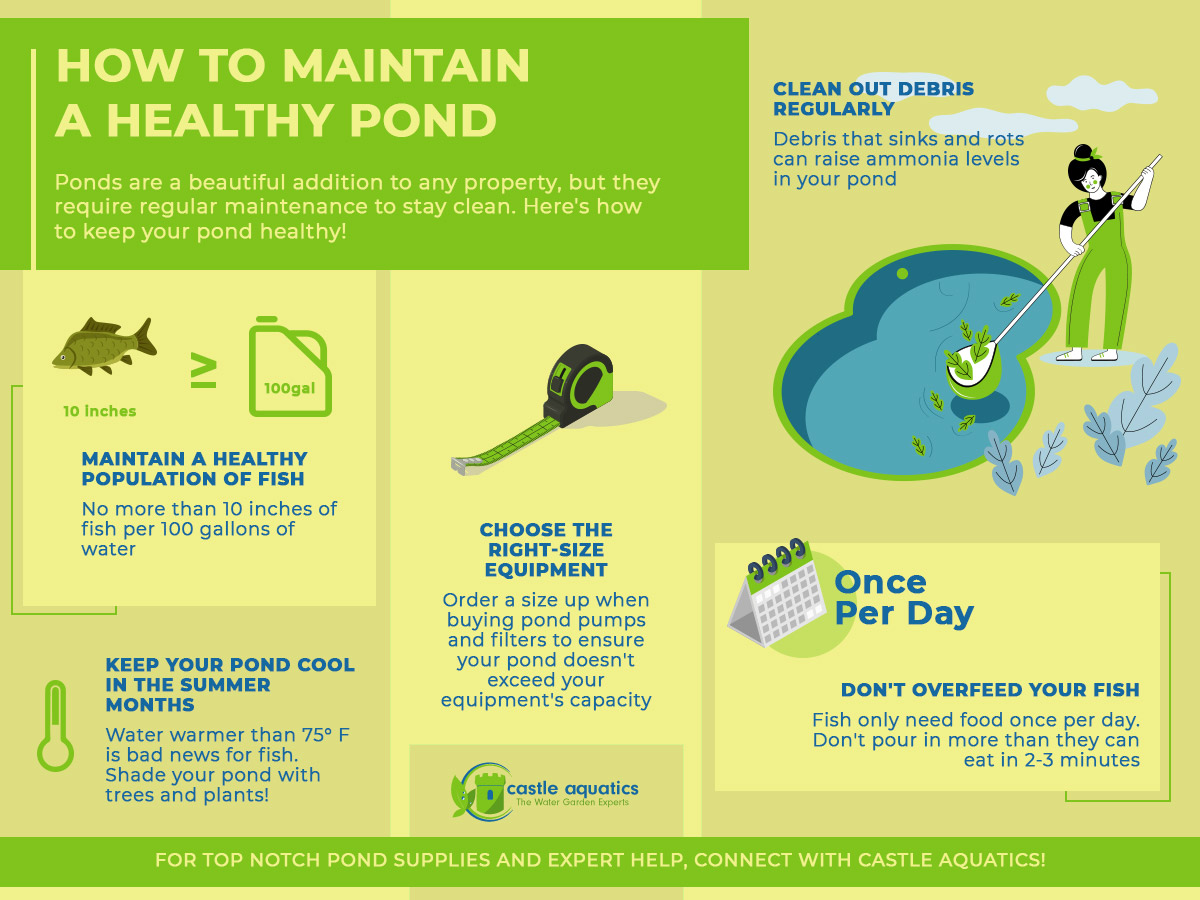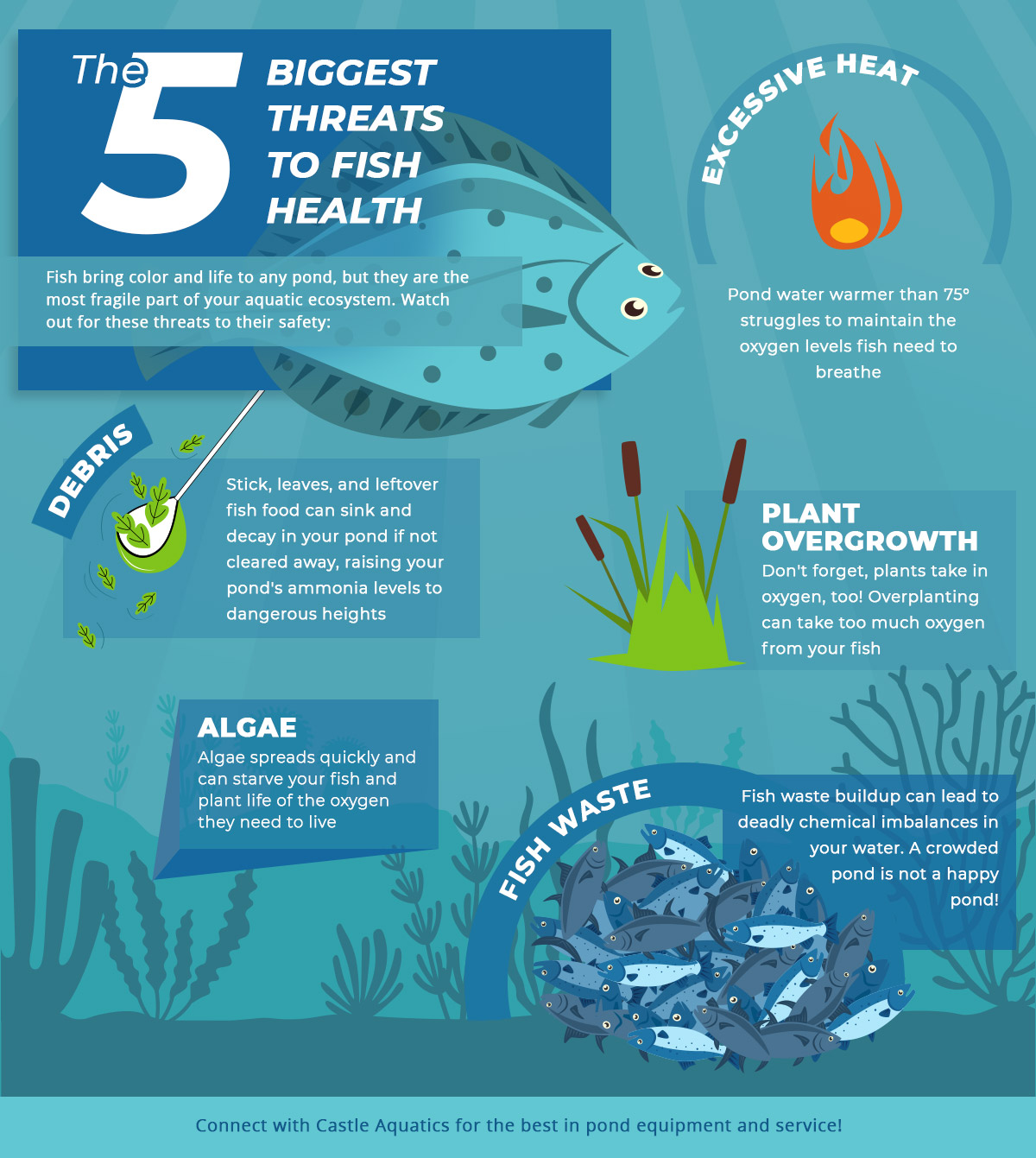7 Steps For Maintaining A Clean Pond
Most pond enthusiasts know that good water quality is integral to the health and aesthetic of any pond habitat. However, for many people new to the world of pond maintenance, sourcing and maintaining good water quality in their home ponds can be a struggle. For instance, you might notice that even with clear waters, your pond’s fish are acting differently. It can be quite confusing for new pond owners!
At Castle Aquatics, we’re passionate about helping people create and maintain breathtaking, healthy ponds that feel just as good for their fishy inhabitants as they look to our eyes. In today’s post, we’ll be sharing seven steps you can (and should) take to maintain a clean pond. With a little knowledge and the right equipment from our online pond shop, you’ll find that pond maintenance can be easy, and even enjoyable! Read on to learn how to get started towards a cleaner, healthier water garden.
- Maintain a healthy population of fish
Everyone loves seeing fish in a pond. With their quick, darting swimming and colorful scales, fish add excitement and life to any pond habitat. However, it’s important not to let your pond get overcrowded.
A good rule of thumb is not let your pond exceed 10” of fish for every 100 gallons of water. That may sound like a lot of room to give fish, but the buildup of fish waste can cause a chemical imbalance in your pond water that can be deadly to your fish if not corrected quickly. Simply put, your fish need space to do their business. If you don’t control your fish population, they could inadvertently threaten themselves.
Have too many fish? Check out our pond shop locator to find a Castle Aquatics partner store near you. Many pond shops will gladly accept your excess fish.
- Don’t over-feed
So goes your fish, so goes their food. Much like you should control the fish population in your pond, you should be careful to feed your fish in moderation. When fish are fed more than they can eat, the unwanted fish food is left to rot in your pond, worsening your water quality and potentially posing health risks to your fish.
So what does feeding your fish in moderation look like? In practice, you should only feed your fish once a day, and not pour in more food than they can eat in two to three minutes. You can browse our fish products for quality fish food that floats if left uneaten, as opposed to lower-quality brands that sink to the bottom of your pond to rot.
- Strike a balance with your plants
When planting a water garden by your pond, be careful to not go overboard — are you beginning to sense the theme of moderation when it comes to pond maintenance? In the peak of summer, you should aim to have 40 to 60% of the surface area of your pond covered or shaded by plants. Overplanting can lead to oxygen deficiencies in your water, as plants take in oxygen at night as part of their photosynthesis process. Your fish need sufficient oxygen in the water to survive. Too few plants, and your pond water could get too hot to be life-sustaining (see Step 6 for more).
- Choose the right-sized pond pump.
Choosing a properly-sized pump is critical to keeping the water in your pond flowing at a healthy rate. Ideally, you should choose a pump with the flow capacity to circulate your entire pond’s water volume at least once every hour. Be sure to check that your pump’s flow isn’t restricted by debris in the skimmer or biological filter when doing so!
It can be tempting to skip over the work of determining your pond’s water volume and shopping around for a pond pump with a corresponding flow rate capacity, but pumping water higher than it was intended can be dangerous for your pond, too. Check out our online Pond Shop locator, and consult an expert near you to find a properly-sized pump for your pond!
5. Be vigilant about cleaning debris.
Cleaning debris can be tedious to some, but is quick and easy when you’ve got one of our high-quality pond skimmer or pond skimmer nets. It’s important to clean debris off the surface of your pond regularly so it doesn’t sink and decay, as rotting debris, along with fish waste and leftover fish food, can cause your pond’s ammonia levels to spike.
Ammonia is very harmful for fish, and should be addressed right away if your water testing supplies indicate a spike. Another sign of dangerously high ammonia levels in your pond is if you see your fish jumping out of the water.
Skimming your with a pond skimmer or skimming net will remove most of the debris from the surface of your pond, but you can also use a pond vacuum to remove leaves and small sticks if they have settled to the pond’s bottom where they’ll decay. Decaying debris, combined with fish waste and leftover fish food, can cause ammonia levels to spike in your pond. You can find ammonia test kits at your local pond shop. If you find the ammonia levels are indeed high, you can treat your pond with any one of our ammonia neutralizing kits.
6. Keep your pond cool during hot months
As we mentioned in Step 3, warm water can be deadly for life in your pond. Dissolved oxygen is key to sustaining fish life in your pond — it’s what they breathe — and when your pond water exceeds 75° Fahrenheit, it struggles to maintain enough dissolved oxygen to keep your fish alive. That’s why we emphasize the importance of keeping your pond shaded by plants in summer months. Alternatively, you can also add an aerator to your pond to help your fish breathe in times of sweltering heat.
7. Select the right pond filter
Much like your pond pump should be the right size for your pond, so too should your pond filter. The ratings for pond filters are based on average water conditions — if your pond has more water volume than a pond filter is rated for, or if your pond consistently has more debris in it than average, you’ll want to select a different pond filter. When shopping for a pond filter, be sure to order a pond filter one size larger than you need so that even if your pond’s water volume increases slightly (after an extended period of heavy rainfall or after significant snowmelt in spring), your pond filter will be able to handle it. And of course, clean it regularly, according to its instruction manual!
If you follow these seven steps diligently, you should be able to enjoy a clean, healthy, fish-filled pond for years to come! As always, if you’re struggling with pond maintenance or coming across problems you don’t know how to fix, be sure to connect with Castle Aquatics! We maintain a nationwide network of pond shops and experts that can provide you local help and expertise with any pond need you could have. Check out our store locator to find a pond partner near you today!


 Stocking Design Center
Stocking Design Center  Stocking Dealer
Stocking Dealer  Dealer
Dealer